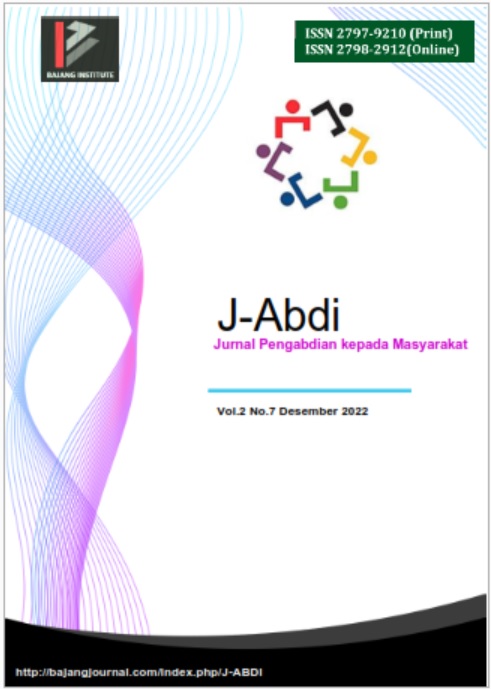EDUKASI PEMANFAATAN OBAT TRADISIONAL SEBAGAI ASI BOOSTER
DOI:
https://doi.org/10.53625/jabdi.v2i7.3956Keywords:
Breastfeeding Boosters, Traditional Medicine, Pattallassang, TakalarAbstract
Various types of plants in the surrounding environment that have medicinal properties are many that can be obtained and utilized, and can even be planted themselves, which are known as family medicinal plants. This medicinal plant has begun to be widely studied, especially Indonesian Native Medicinal Plants, because it has relatively small side effects when compared to modern medical drugs. Communities in Pattallassang District generally have various types of medicinal plants that are planted in their yards and are often used as alternative treatments for certain types of diseases or as supplements, one example being breastfeeding boosters, which are very much needed by mothers in carrying out their activities. exclusive breastfeeding program. To support the exclusive breastfeeding program, various efforts must be made, one of which is the use of breastfeeding boosters, which is expected to help increase the production of breast milk. The purpose of the community service activity is to increase understanding of the importance of exclusive breastfeeding and to provide education about the use of several plants that have the potential as breastfeeding boosters in terms of processing techniques and more rational ways of using them. This service is carried out at Merpati Posyandu, Pattallassang Village, Pattallassang District, Takalar Regency. The method of providing community service activities is by providing counseling and demonstrations on how to process and manufacture good traditional medicines. The results of the activity assessment showed that participants gained knowledge about the types of traditional medicines, especially breastfeeding boosters, along with good processing and manufacturing methods of traditional medicines.
References
Acharya, Deepak & Shrivastava A.2008. Indigenous Herbal Medicines: Tribal Formulations and Traditional Herbal Practices. Aaviskhas Publisher Distributor, Jaipur-India.
Anggraeni, N. (2016). Pengaruh konsumsi temulawak oleh ibu nifas terhadap kelancaran produksi ASI. Jurnal Nursing, 7(1), 1-6.
Hanifah, S. A. (2017). Karakteristik ibu menyusui tidak memberikan ASI eksklusif di Desa Cikeruh Kecamatan Jatinangor Kabupaten Sumedang Tahun 2015. Jurnal Fakultas Kedokteran Universitas Padjajaran JSK, 3(1),38-43.
Kartika, V.M. (2016). Hubungan dukungan keluarga dengan keberhasilan pemberian ASI eksklusif pada ibu bekerja di Wilayah Kerja Puskesmas Bringin Kabupaten Semarang, Sekolah Tinggi Ilmu Kesehatan Ngudi Waluyo.
Kementerian Kesehatan. (2014). Pedoman Gizi Seimbang.
Kementerian Pertanian. (2014). Statistik Produksi Hortikultura Tahun 2014. Statistik Produksi Hortikultura Tahun 2014, 286.
Paryono, A. K. (2014). Kebiasaan konsumsi jamu untuk menjaga kesehatan tubuh pada saat hamil dan setelah melahirkan di Desa Kajoran Klaten Selatan. Jurnal Terpadu Ilmu Kesehatan, 3(1), 64-72.
Peraturan Menteri Kesehatan Nomor 75 Tahun 2014 tentang Pusat Kesehatan Masyarakat. Jakarta.
Prastiwi, R. S (2018). Pengobatan tradisional (jamu) dalam perawatan kesehatan ibu nifas dan menyusui di Kabupaten Tegal. Jurnal Siklus, 7(1), 263-267.
Salan, R. 2009. Penelitian faktor-faktor Psiko Sosio Kultural dalam pengobatan tradisional tiga daerah, Palembang, Semarang, Bali. Jakarta. Badan Penelitian dan Pengembangan Kesehatan, Pusat Penelitian Kanker dan Pengembangan Radiologi, Departemen Kesehatan RI.
Setiawandari. (2017). Efektifitas ekstrak sauropus androgynus (daun katuk) dan ekstrak moringa oleifera lamk (daun kelor) terhadap proses persalinan, produksi kolostrumdan proses involusi uteri ibu postpartum embrio. Jurnal Kebidanan, 9(1), 16-23.
Suli A. 2012. Eksistensi Pemanfaatan Obat Tradisional di Era Medikalisasi Kehidupan. Jurnal Penelitian Pengelolaan Sumber Daya Alam dan Lingkungan 1(3): 225-234.
WHO, Essential Medicines and Health Products, diakses tahun 2018
Wiji, R. N. (2013). ASI dan panduan ibu menyusui. Yogyakarta: Nuha Medika.














